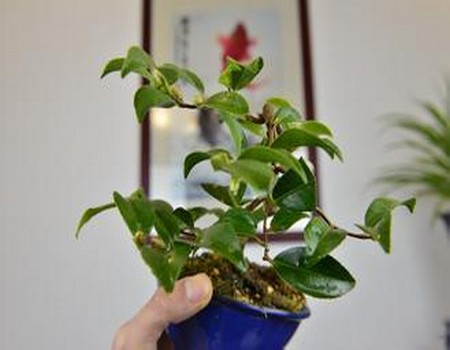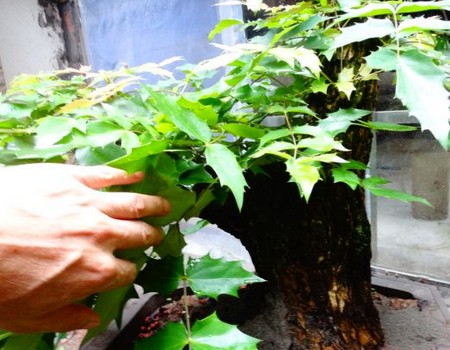Culture methods and matters needing attention of potted tea plum
Camellia oleifera has a variety of colors, long flowering period, magnificent color, light and elegant, beautiful tree shape, most branches expand horizontally, full posture, and a large amount of flowers, so it is very suitable for pot appreciation, and it is one of the ideal flowers to watch flowers in winter. Many people wonder whether Camellia or plum blossoms are camellias or plum blossoms, just because they are similar to both, so they can only take half of them, so they get the name Camellia. Although tea plum has a long flowering period, it is an excellent choice to watch flowers, but it is necessary to be more careful in daily maintenance. The following is to introduce the breeding methods and matters needing attention of potted tea plum.

[soil]
Camellia oleifera is suitable for growing in loose, fertile and well-drained acid sandy soil, while alkaline soil and clay are not suitable for planting tea plum, preferably humus-rich and moist slightly acidic soil, and the pH value of 5.5 is the best.
[light]
Camellia oleifera is naturally fond of shade, so it is best to grow in a half-yin and half-yang environment. Strong summer light may burn its leaves and shoots, causing the leaves to curl and fall off, but proper light is needed to make the flowers bloom and bloom.
[temperature]
Camellia oleifera is cold-tolerant, but potted plants should not be less than 2 ℃ below zero, and the most suitable growth temperature is 18 ℃-25 ℃.
[watering]
Watering must be thoroughly watered once a day in summer and once a few days in winter. In addition to winter, water should be sprayed on the leaf surface every few days to keep the leaf surface clean.
[fertilization]
The fertilization of tea plum is suitable for light, especially in the seedling stage. Generally, human urine can be applied 1 or 2 times from February to March to promote the growth of branches and leaves, cake fertilizer and water once from April to May to promote flower bud differentiation, and phosphate fertilizer from September to October to promote its flowering, which is also beneficial to winter.
The tea plum of many flower friends will appear the phenomenon of stiff flowers, that is to say, its buds are already dead. To avoid this phenomenon, you should pay attention to the following points:
1. Avoid too high room temperature
Family potted tea plum is in a state of semi-dormancy in cold winter and early spring, and the suitable temperature is 2-10 ℃. When the average temperature exceeds 10 ℃, it will promote its vegetative growth, thus competing for the nutrients needed by the developing bud, causing it to gradually wither.
2. Avoid unsmooth air
Whether the family can keep the air fresh is also the key to prevent and cure the stiff buds of domestic tea plum. The right thing to do is:
(1) regularly open the window for air, it is best to open the window every morning and evening for about ten minutes at a time to keep the indoor air fresh.
(2) avoid contact with harmful gases. First, do not smoke indoors as much as possible, after closing the window, the smoke will not run out, which will be disadvantageous to the tea plum; the second is not to put it in dirty places such as kitchens and toilets to prevent the toxicity of oil, dirt and gas; third, do not put tea plum "stuffy" in the newly decorated room, if you want to decorate, it is best to choose non-odor and non-toxic materials to prevent poisoning.
(3) the air pollution in the city or near the industry and mine is serious. When the leaves accumulate dust, they should be cleaned in time to keep their normal breathing so as to facilitate their growth and flower protection.
3. Avoid frequent work and change places
Some families love to change the placement of potted flowers, which can easily disrupt their growth rules and affect their growth and normal flowering. After entering the house in winter, potted tea plum belongs to the semi-dormant period of stopping vegetative growth and entering bud expansion, and it is more necessary to have a stable cool and wet environment. Especially when it is about to blossom, it should be paid more attention. If it is suddenly moved from the balcony with stronger light and lower temperature to the room with darker light and higher temperature when it blossoms in winter and spring, or from the balcony of the north house to the south room with higher temperature and plenty of sunshine, it will not only have stiff buds and flowers, but also a large number of fallen leaves. Growth frustrated. Therefore, do not change positions frequently.
4. Avoid leaving too many buds
Some families are reluctant to cut off too many buds. As a result, the buds are enlarged and gratifying when they first enter the room, and then gradually wither after one end of time. The incubation period of flower buds is very long, and some varieties are even "pregnant in October". A lot of nutrients need to be consumed from bud gestation to flowering. If a large number of buds are not thinned in time, it is difficult to ensure that there are enough nutrients for bud development and flowering in the later stage. As a result, the efforts of cultivation are often wasted a year ago, not only can not even see a normal flower, but also make the plant tired and even lead to death.
5. Fertilization before flowering is prohibited.
Although a lot of nutrients are needed in winter and spring bud development and flowering season. However, fertilization before flowering will often "top" off the huge buds, resulting in stiff buds and stiff flowers. Therefore, potted tea plum blossoms generally do not apply fertilizer after entering the house in winter. In order to ensure normal flowering, it is important to strengthen the fertilizer and water management in the vegetative growth period, which can be divided into spring and summer stages. After blooming in spring to before sprouting, even if thin alum fertilizer is applied for 1 or 2 times and the shoot is no longer delayed, fertilization is the most likely to burn the camellias.
Summer fertilization can be in the spring shoot aging after June, when the amount of fertilizer can be slightly larger, and can be applied continuously (once every ten days, 2 times for 3 times). Stop fertilizing after late September, otherwise it is easy to stiff buds and flowers in winter.
[notes]
1. The basin soil should be suitable.
Potted tea plum should choose loose texture, fertile, smooth drainage, slightly acidic culture soil. The culture soil mainly composed of rotten leaf soil or peat soil should be used in the north.
2. Shade in the height of summer
In the middle of summer, tea plum should be shaded, strong light should be avoided at noon, and more sunlight can be exposed in the morning and evening, which is conducive to flower bud differentiation and flower bud development.
3. Keep warm in winter
In winter, tea plums should be moved indoors for the winter, and other seasons can be maintained in the shade. The room temperature in winter should not exceed 7 ℃, preferably 3 ℃-6 ℃.
Time: 2019-06-01 Click:
- Prev

Maintenance and management methods of broad-leaf bonsai
The name "ten meritorious works" does not sound like the name of a plant at all, but it happens to be a kind of plant, and because it can be used not only to medically treat a variety of diseases, but also to embellish and beautify the environment, so it has high economic value.
- Next

Flowering time and Culture method of Cymbidium
Smiling gentleman orchid is a kind of gentleman orchid, when the flower blossoms, each floret sagging in the shape of a bell, seems to bow his head and smile to people, hence the name of laughing gentleman orchid. Smiling gentleman orchid elegant and solemn, narrow leaves, orange flowers, open drooping, bucket-shaped, is the layout of the venue during the Spring Festival
Related
- Fuxing push coffee new agricultural production and marketing class: lack of small-scale processing plants
- Jujube rice field leisure farm deep ploughing Yilan for five years to create a space for organic food and play
- Nongyu Farm-A trial of organic papaya for brave women with advanced technology
- Four points for attention in the prevention and control of diseases and insect pests of edible fungi
- How to add nutrient solution to Edible Fungi
- Is there any good way to control edible fungus mites?
- Open Inoculation Technology of Edible Fungi
- Is there any clever way to use fertilizer for edible fungus in winter?
- What agents are used to kill the pathogens of edible fungi in the mushroom shed?
- Rapid drying of Edible Fungi

